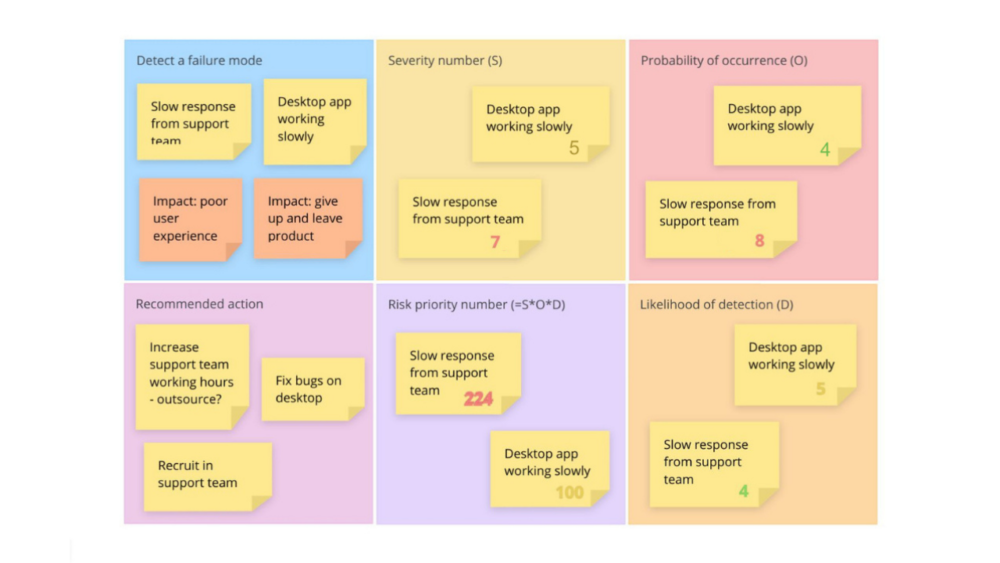FMEA template

Ayoa’s FMEA template helps you to identify issues with a product, service or process and rank them according to their impact, so you can prioritize the order in which they are addressed.
What is FMEA (Failure Mode and Effects Analysis)?
FMEA stands for Failure Mode and Effects Analysis and is an effective tool for organizations to analyze their products, services and processes. It requires teams to work together to identify issues with their business processes or the products and services they provide to customers, so they rank their potential impact and develop an effective plan of action, as well as prioritize the order in which each issue should be addressed. An FMEA can help you do this by requiring you to identify a problem, estimate its impact and assign a severity ranking to it.
There are a number of scenarios where you may want to conduct a Failure Mode and Effects Analysis with your team. These include fixing issues in a product or service to improve customer satisfaction or prevent a problem before it has even had the chance to arise. This method can also be used to examine existing processes and determine whether you can improve efficiency and production quality, as well as reduce time, costs and other waste.
Why should you use our FMEA template?
Conducting an FMEA can be beneficial for various departments within an organization, such as design, development, customer service, sales and marketing. By using this method to identify problems with a service, product or process early on, you can minimize the impact this has on your customers and employees, which will save your business time and money in the long-run. No one wants to lose money, time, or customers due to problems that can easily be fixed, and using a Failure Mode and Effects Analysis can help you to define time frames for fixes and better prioritize which ones should be addressed first.
By requiring you to conduct an in-depth analysis of every problem you identify with a product, service or process, this activity encourages team collaboration and the ability to be innovative with your problem-solving, which can help you to uncover aspects of the issue that you might have otherwise never considered. As a matter of fact, the colorful and visually stimulating nature of our FMEA template will help to boost your creative thinking ability, which is highly beneficial when identifying a range of possible impacts.
How to use our FMEA template
Our premade template is already populated with the sections you need to help you identify your issues and their potential impact. Discover how to use our FMEA template below.
To access the template, sign up to Ayoa. Once you've signed up, navigate to the homepage to create a new whiteboard, mind map or task board and choose this template from the library.
Agree on the product, service or process that you want to examine with your team. Remember that although an FMEA can be used to examine virtually any process, it’s better to choose one that has multiple steps and potential failure points.
DETECT A FAILURE MODE. Think about the different parts of your product or service (or steps of the process) and detail any issues related to each (such as ways in which it might fail to perform its intended function). Add these to the relevant section of the template using sticky notes. You should also outline the effects (or ‘impacts’) these failures could have, trying to be as specific as possible.
SEVERITY NUMBER. Rank the severity of each failure based on the impact it will have on your operations, customers or employees. Rank these out of 10 with 1 meaning that it has a minimal effect and 10 meaning that it has a devastating impact.
PROBABILITY OF OCCURRENCE. Thinking back to the failures you identified, rank the probability of them occurring on a scale of 1 to 10. Remember, 1 means it isn’t that likely to occur, while 10 means it happens very frequently.
LIKELIHOOD OF DETECTION. Determine the probability of each failure being detected and acted upon before it has had a chance to occur. Again, rank this out of 10, with 1 meaning it’s very likely to be detected.
RISK PRIORITY NUMBER. Calculate the Risk Priority Number (or RPN) using the following calculation: severity X occurrence X detection.
RECOMMENDED ACTION. Now that you have your RPNs, it’s time to develop an effective plan of action. With your team, brainstorm the actions they can take to solve these issues. Who will be responsible for carrying out each action? What timeframe do you need to carry out these actions?
